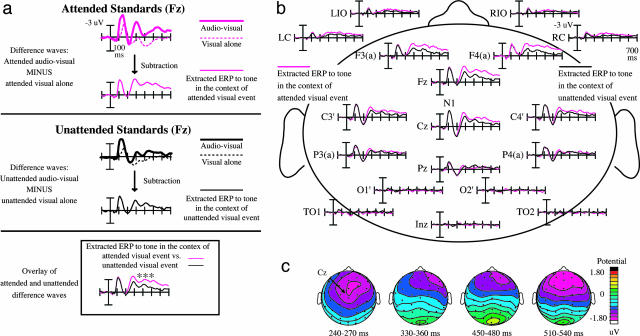Fig. 3.
Multisensory object-based attention effect on the task-irrelevant midline tones, collapsed across the attend-left and attend-right conditions. (a) Sequence of ERP subtractions leading to the isolation of the multisensory attention effects for the tones, shown at frontal site Fz. (Top) Attended condition: A mixture of auditory and visual components can be seen in the ERP to the combined audiovisual events (thick trace). The subtraction of the visual-alone ERP (dotted trace) from the audiovisual ERP yields the “extracted” ERPs to the tones in the context of an attended visual stimulus (thin solid trace). (Center) Unattended condition: The analogous subtraction is performed on the unattended unisensory visual standards (dotted trace) and the unattended visual standards paired with a central tone (thick trace). The thin solid trace shows the corresponding unattended-condition difference wave of the multisensory minus unisensory-visual ERPs. (Bottom) The extracted difference waves overlaid, revealing the multisensory attention effect on the synchronous tones. An attention-related difference, a frontally distributed processing negativity, emerges ≈220 ms and lasts for hundreds of milliseconds. (b) Multisensory object-based attention effect, for a number of electrode sites, laid out as on the subject's head. Although there is no difference between the attention conditions on the early auditory components (P20-50, N1), a sustained attentional difference starts to emerge at ≈220 ms over fronto-central and frontal sites and lasts for >400 ms. (c) Topographic voltage maps for the multisensory attention effect on the spatially discrepant tones. Shown are the difference maps for tones in the context of an attended vs. unattended lateral visual stimulus (see corresponding ERP waves in b). This attentional difference is maximal over fronto-central and frontal sites, similar to that of the attention-related N1 effect and processing negativity elicited by attended auditory stimuli in auditory attention experiments.

